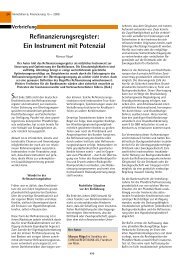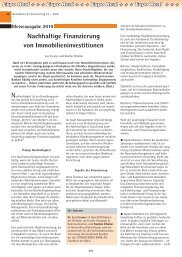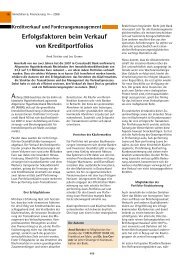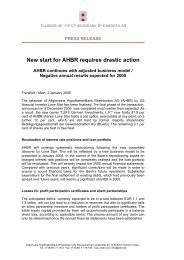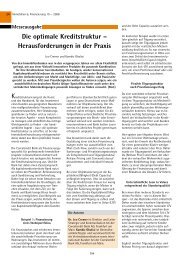COREALCREDIT BANK AG
COREALCREDIT BANK AG
COREALCREDIT BANK AG
Create successful ePaper yourself
Turn your PDF publications into a flip-book with our unique Google optimized e-Paper software.
Generally, the Issuer's profitability is tied to its access to low cost funds. Due to the nature of the<br />
Issuer's business, it does not have access to a large base of customer deposits as an inexpensive<br />
source of funds. Its source of funds predominantly derives from the issue of Pfandbriefe. Other<br />
funding sources are bearer securities in the form of senior unsecured notes, subordinated notes,<br />
Securitisation and Syndication.<br />
Particularly in view of the current financial market crisis and the tight market situation the Issuer's<br />
costs of funds may prove to be more expensive in the future than was the case historically and<br />
more expensive than currently contemplated in the Issuer's plans.<br />
This circumstance may also affect the issuance of Pfandbriefe as it cannot be excluded that also<br />
the refinancing costs for the issuance of Pfandbriefe increase, in particular if the value of the<br />
assets in the cover pool deteriorates. Under extreme market conditions the sale of securities,<br />
including Pfandbriefe, may become temporarily impossible. Furthermore, a decrease in<br />
creditworthiness of the Issuer or an increase in the risk positions of its financing portfolios may<br />
have the same effect for unsecured securities and money market instruments.<br />
In the light of the continuing financial market crisis and the still constrained money market and<br />
capital market, the Issuer submitted an application for a framework guarantee of bonds<br />
(Schuldverschreibungen) to the German Financial Market Stabilisation Fund (Sonderfonds<br />
Finanzmarktstabilisierung – SoFFin) in order to further strengthen its liquidity situation. This<br />
framework guarantee has been granted in the amount of EUR 500 million, subject to particular<br />
conditions to be met by the Issuer's sole shareholder. By the end of the first quarter 2011, all<br />
SoFFin-guarateed bond issues have been redeemed prior to original maturity.<br />
Operational Risks<br />
Operational risk describes the risk of losses arising from insufficient or erroneous internal<br />
processes, employees, and systems, as well as external events. It is caused by human errors,<br />
systems failures and insufficient controls and processes. Legal risks are also part of the<br />
operational risk; legal risks, in particular, arise from uncertainty as to the outcome of legal actions<br />
or uncertainty in the applicability or interpretation of contracts, laws or regulations.<br />
Counterparty Risks vis-à-vis Financial Institutions<br />
The Issuer defines counterparty risk in relation to financial institutions as the potential losses in<br />
value or foregone profit, which may occur through unexpected default or deterioration of the credit<br />
quality of trading counterparties with whom the bank has entered into securities transactions,<br />
money market, interest rate or currency derivatives, as well as securities repurchase transactions.<br />
Regulatory Risk<br />
The Issuer's business is subject to detailed, comprehensive laws and regulations as well as<br />
supervision. Changes in existing laws and regulations may effect the way in which the Issuer<br />
conducts its business and the products the Issuer may offer. Changes in regulations relating to<br />
financial services, securities products and transactions may materially adversely affect its<br />
businesses by restructuring the Issuer's activities, imposing increased costs or otherwise.<br />
Real Estate Business, Business and Strategic Risk<br />
As a credit institution, the Issuer is exposed to the creditworthiness of its customers and<br />
counterparties. If the value of the collateral securing the loan portfolio declines, the Issuer will be<br />
exposed to higher credit risk and increased risk of non-recovery in the event that any of its loans<br />
fail to perform. The Issuer cannot assure that its level of risk provisioning will be adequate or that it<br />
will not have to make significant additional provisions for possible bad and doubtful debts in future<br />
periods.<br />
34






